organicchemist25
Hazard to Others
  
Posts: 136
Registered: 12-2-2014
Member Is Offline
Mood: No Mood
|
|
First attempt Grignard since Ochem II cyclopentyl bromide
Last night I attempted my first Grignard since undergrad. I do not think it went well.
I reacted cyclopentyl bromide with Mg. I really have no clue why it failed, at least I think it did. I used 119g of cyclopentyl bromide with 19.4g Mg
turnings.
Everything was dry. Glassware was flamed 3 Times. Immediately after the third time I put my drying tubes with calcium chloride in place and allowed to
cool. Ether was sodium dried for 1 day. There was no more bubbling with the Na. Then freshly distilled and used. The cyclopentyl bromide was from a
reputable company and states 99>%. It was slowly dripped in after the ether and mg started bubbling and going good. I did add a tiny iodine
crystal.
It started going nicely. At one point it going a little vigorous and the ether was about at the top of my 3 foot condenser. I cut off the bromide and
after about 30 seconds it stabilized. This reaction went on for about an hour. Then it just died out. There is quite of mg left in the flask. There is
about a half inch of gray transparent layer on the top, but looks like quite a bit of mg was leftover.
Any advice or ideas on what may have went wrong please share.
The only things I’m questioning is
1. I did space putting a stir bar in. (But would that totally cause it to fizz out early)
2. I didn’t bake the magnesium. Thought about that after, but was sealed in a bag that was sealed.
3. The amount of ether I used was not a measured amount, but there was no published amount of ether to use. It just started “Grignard reacted in
sodium dried ether”. Other synths for grigs I’ve read have an amount of ether to use. I used around 175ml on my run.
These are my only questioning about it.
Would dry THF be better? I have that, too.
Any input would be truly appreciated.
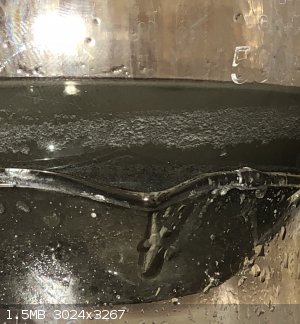 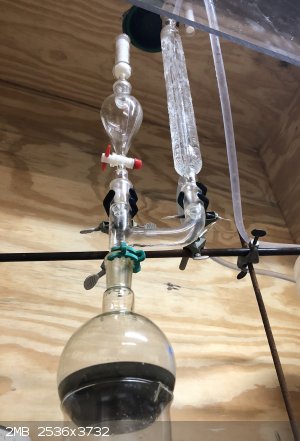 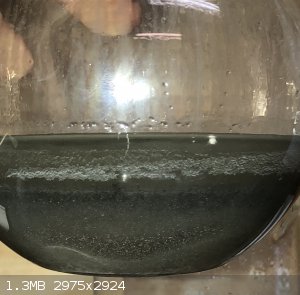 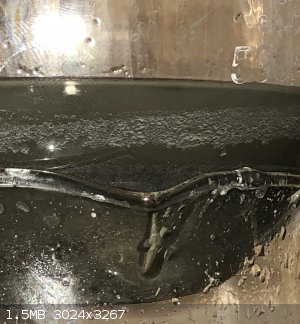 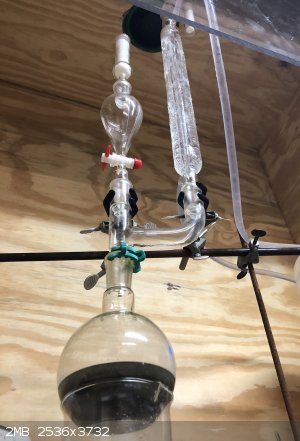 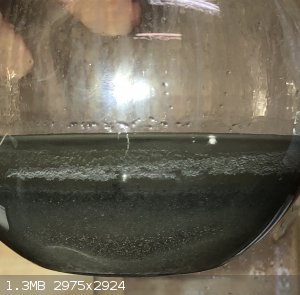
[Edited on 31-3-2018 by organicchemist25]
[Edited on 31-3-2018 by organicchemist25]
|
|
|
zed
International Hazard
    
Posts: 2277
Registered: 6-9-2008
Location: Great State of Jefferson, City of Portland
Member Is Offline
Mood: Semi-repentant Sith Lord
|
|
Umm. More Ether required?
Ether is both solvent, and a complexing agent.
Might require more Ether, or the use of heat.
You have what you have, but perhaps heat, and a long reflux, will be required to drive the reaction to completion.
I've run a few Grignards, and at the time, I thought I had done OK. I got some product. Which Of course, I considered a triumph.
Based on information later accrued, my technique was probably less than great.
My stuff, looked a lot like your stuff. Probably not completely "cooked".
But, I must defer to those who know more.
What do you guys think?
|
|
|
Dr.Bob
International Hazard
    
Posts: 2658
Registered: 26-1-2011
Location: USA - NC
Member Is Offline
Mood: No Mood
|
|
I always use excess Mg, did not do the math, but it looks like you have well over 1 eq, so some should be left.
Simplest test is let it settle, suck out a little bit and add to water, if it reacts violently, likely worked. Or react with dry ice and look for
the cyclopentyl acid forming. The biggest two side reactions I see in them is traces of water giving some cyclopentane with the Grignard, which
always happens to some degree in most real life reactions. The other common issue is if the reaction overheats, it can dimerize the Grignard into
dicyclopentane, that would be pretty hard to do, due to sterics, but a common side product.
The amounts look reasonable, a bit concentrated, maybe, but often that helps start it. I often dissolve the bromide in some ether to keep the
reaction diluted as I add more bromide, as well as make it easier to add the bromide slowly.
|
|
|
Chemi Pharma
Hazard to Others
  
Posts: 349
Registered: 5-5-2016
Location: Latin America
Member Is Offline
Mood: Quarantined
|
|
Think about try these things:
I- Adding an iodine crystal as a catalyser;
II - stirring uninterruptedly the reaction mix with an stir bar while adding the alkyl halide;
III - diluting the alkyl halide in diethyl ether before adding it into the ether-magnesium solution drop by drop;
IV - Using ultrasound apparatus, what increase the reaction speed and allow grinard reactions to run even with wet diethyl ether, like said in the
paper I attached below (by Rhodium):
Attachment: Grignard Reactions in _Wet_ Ether (Ultrasound Activation).pdf (44kB)
This file has been downloaded 589 times
|
|
|
organicchemist25
Hazard to Others
  
Posts: 136
Registered: 12-2-2014
Member Is Offline
Mood: No Mood
|
|
Quote: Originally posted by zed  | Umm. More Ether required?
Ether is both solvent, and a complexing agent.
Might require more Ether, or the use of heat.
You have what you have, but perhaps heat, and a long reflux, will be required to drive the reaction to completion.
I've run a few Grignards, and at the time, I thought I had done OK. I got some product. Which Of course, I considered a triumph.
Based on information later accrued, my technique was probably less than great.
My stuff, looked a lot like your stuff. Probably not completely "cooked".
But, I must defer to those who know more.
What do you guys think? |
So, is there the need to calculate the amount of ether? If there is, which makes sense, how does one go about it? Is it equivalent to the reagents
involved? Like I had mentioned others preps have an amount of ether to be used. Mine does not and I could not locate anything else with more detail on
ether amount.
|
|
|
organicchemist25
Hazard to Others
  
Posts: 136
Registered: 12-2-2014
Member Is Offline
Mood: No Mood
|
|
Quote: Originally posted by Chemi Pharma  | Think about try these things:
I- Adding an iodine crystal as a catalyser;
II - stirring uninterruptedly the reaction mix with an stir bar while adding the alkyl halide;
III - diluting the alkyl halide in diethyl ether before adding it into the ether-magnesium solution drop by drop;
IV - Using ultrasound apparatus, what increase the reaction speed and allow grinard reactions to run even with wet diethyl ether, like said in the
paper I attached below (by Rhodium): |
I appreciate the attachment. I read it. I am going to look for an ultrasonic instrument to add to the lab. I have read in other preparations where
the halide was mixed with ether in the addition funnel. I didn’t do that and the prep didn’t mention. Is there a ratio to dilute the halide with
the ether? Lastly, if there is a determined amount of ether to use in the reaction would the ether in the funnel be additional, added up on the total
volume to be used? Thanks
I did add a spec of iodine.
|
|
|
organicchemist25
Hazard to Others
  
Posts: 136
Registered: 12-2-2014
Member Is Offline
Mood: No Mood
|
|
Quote: Originally posted by Dr.Bob  | I always use excess Mg, did not do the math, but it looks like you have well over 1 eq, so some should be left.
Simplest test is let it settle, suck out a little bit and add to water, if it reacts violently, likely worked. Or react with dry ice and look for
the cyclopentyl acid forming. The biggest two side reactions I see in them is traces of water giving some cyclopentane with the Grignard, which
always happens to some degree in most real life reactions. The other common issue is if the reaction overheats, it can dimerize the Grignard into
dicyclopentane, that would be pretty hard to do, due to sterics, but a common side product.
The amounts look reasonable, a bit concentrated, maybe, but often that helps start it. I often dissolve the bromide in some ether to keep the
reaction diluted as I add more bromide, as well as make it easier to add the bromide slowly. |
I used .8 mole of Mg and .8 mole of the halide. But, I know the Mg is +2 and Br is -1. I went off the prep, but a half of mole of Mg may be better on
a future run.
If that is the case, then all of my halide should have went to completion, hopefully. I’m going to check it soon with your advice with water. Thank
you.
|
|
|
organicchemist25
Hazard to Others
  
Posts: 136
Registered: 12-2-2014
Member Is Offline
Mood: No Mood
|
|
There are some cloudy/clear crystals that formed around the flask. I have read that Grignards can form a precipitate. Is the precipitate of
importance, or ignored and only the solution? Also, a white film all around the top half of the boiling flask. I’m attaching a pic.
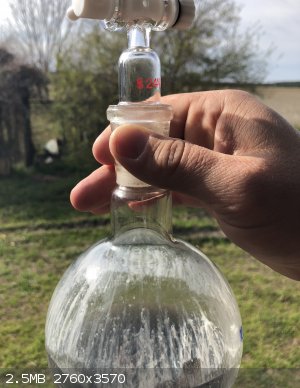 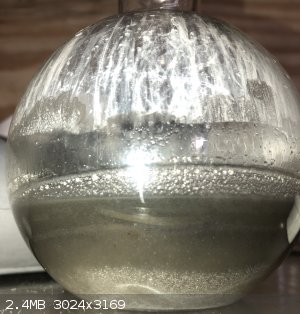
|
|
|
zed
International Hazard
    
Posts: 2277
Registered: 6-9-2008
Location: Great State of Jefferson, City of Portland
Member Is Offline
Mood: Semi-repentant Sith Lord
|
|
Search out a published preparation. If you can.
Re-inventing the wheel, is not the way to go.
Chemists probably spent a hundred years or so, tweaking reaction conditions to get best results.
Let their decades of suffering, not be in vain.
|
|
|
Dr.Bob
International Hazard
    
Posts: 2658
Registered: 26-1-2011
Location: USA - NC
Member Is Offline
Mood: No Mood
|
|
Mg needs to be at least 1 full equivalent, as RMgBr is major product, not R2Mg, under normal conditions. I use at least 2 equivalents. If there is
Mg left, just keep refluxing the ether until it stops disappearing. The white crystals are like the acid from reaction with traces of CO2 in the
air, the Grignard itself or MgBr2, which may form in small amounts. Most Grignards are simply done at moderately high concentrations compared to
many other reactions, but no perfect standard, but often done at 1-2 Molar in the bromide, which would be 800 ml for your scale, so you are perhaps
too concentrated. The grignard may not be soluble at that concentration.
|
|
|
Texium
Administrator
       
Posts: 4508
Registered: 11-1-2014
Location: Salt Lake City
Member Is Offline
Mood: PhD candidate!
|
|
Another thing that would be good to consider in the future is not doing a reaction that you've never done before on such a large scale...
I always run reactions on a small (gram or two) scale, sometimes multiple times before scaling up. It's good practice to work out the kinks and
unexpected issues before you lob all of your expensive reagents into the big glassware.
All is not lost though. It looks like you have room for more ether, so add some more if you can. Then try refluxing it for a while, as others have
suggested. While Grignards form vigorously at first, they seem to need a little convincing after about half has formed.
|
|
|
notoxicshit
Harmless

Posts: 37
Registered: 18-4-2016
Member Is Offline
Mood: No Mood
|
|
I dont understand what leads you to believe that there is a problem with your reaction besides too little ether.
Your reaction started and thats what is the trouble most people have, but yours went fine.
Why did you only do half the reaction?
Grignard is a coupling reaction, so why didnt you just add some solvent to dissolve the sludge, let it react and add your other reagent?
Could have turned out okay.
|
|
|
organicchemist25
Hazard to Others
  
Posts: 136
Registered: 12-2-2014
Member Is Offline
Mood: No Mood
|
|
Quote: Originally posted by notoxicshit  | I dont understand what leads you to believe that there is a problem with your reaction besides too little ether.
Your reaction started and thats what is the trouble most people have, but yours went fine.
Why did you only do half the reaction?
Grignard is a coupling reaction, so why didnt you just add some solvent to dissolve the sludge, let it react and add your other reagent?
Could have turned out okay. |
I did add more [dry] ether, refluxed for 3 hours. All Mg dissolved. It reacted vigorously with water. I am pleased with the outcome. I’m certain
there is room for improvement. I have it reacting with a nitrile now for 3 days. I am going to do smaller scale with a few different Grignards to
improve on technique and get more experience.
I appreciate all of your tips and information.
|
|
|
organicchemist25
Hazard to Others
  
Posts: 136
Registered: 12-2-2014
Member Is Offline
Mood: No Mood
|
|
Thank you all for the help on this. I did get all the mg to completely dissolve. I added 175 additional mLof dry ether. Refluxed for 3 additional
hours. Reacted very vigorously with water. Instantly precipitation when dropped in a watch glass and evaporated. Reacting with a nitrile now.
|
|
|
Melgar
Anti-Spam Agent
    
Posts: 2004
Registered: 23-2-2010
Location: Connecticut
Member Is Offline
Mood: Estrified
|
|
You can't just buy cyclopentyl bromide at the supermarKET. AMINE, it's a pretty difficult chemical to find.
[Edited on 4/6/18 by Melgar]
The first step in the process of learning something is admitting that you don't know it already.
I'm givin' the spam shields max power at full warp, but they just dinna have the power! We're gonna have to evacuate to new forum software!
|
|
|
Sigmatropic
Hazard to Others
  
Posts: 307
Registered: 29-1-2017
Member Is Offline
Mood: No Mood
|
|
One can only assume what nitrile that must be...
Attachment: download.webp (3kB)
This file has been downloaded 671 times
|
|
|
DDTea
National Hazard
   
Posts: 940
Registered: 25-2-2003
Location: Freedomland
Member Is Offline
Mood: Degenerate
|
|
Everyone seems to have their own tricks for running Grignard reactions. A few I've come across: treat the Mg with dibromoethane, iodine, or bromine
to expose an active surface; use ultrasound; throw in some lithium chloride...
None of them really work for me. I always end up with metal turds whenever I do a reaction with Mg(0) or Li(0). Even after heating to reflux. Of
course, reflux in diethyl ether might as well be ambient temperature where I am.
So I just filter off the metal junk (cannula filtration) and titrate the resulting homogeneous solution.
"In the end the proud scientist or philosopher who cannot be bothered to make his thought accessible has no choice but to retire to the heights in
which dwell the Great Misunderstood and the Great Ignored, there to rail in Olympic superiority at the folly of mankind." - Reginald Kapp.
|
|
|
TheVoid
Harmless

Posts: 10
Registered: 5-1-2018
Member Is Offline
Mood: No Mood
|
|
Quote: Originally posted by organicchemist25  | Quote: Originally posted by Chemi Pharma  | Think about try these things:
I- Adding an iodine crystal as a catalyser;
II - stirring uninterruptedly the reaction mix with an stir bar while adding the alkyl halide;
III - diluting the alkyl halide in diethyl ether before adding it into the ether-magnesium solution drop by drop;
IV - Using ultrasound apparatus, what increase the reaction speed and allow grinard reactions to run even with wet diethyl ether, like said in the
paper I attached below (by Rhodium): |
there are a few good videos on youtube of people doing grignards and the role ether plays |
|
|
|